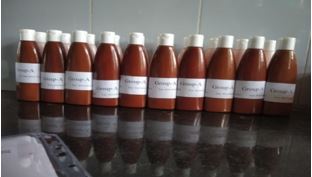Development and Physico-Chemical Analysis of Varnya Lepa Sunscreen Lotion (In-Vitro)
DOI:
https://doi.org/10.21760/jaims.7.5.6Keywords:
UV radiation, Varnya Lepa Sunscreen Lotion, Sun Protection Factor.Abstract
Background: Direct exposure to Solar radiation causes many harmful effects on the skin like suntan, sunburn, hyperpigmentation and skin ageing etc. To overcome these types of problems sunscreen applications can be helpful. In Ayurveda, authors explained Varnya Lepa drugs like Raktachandana (Pterocarpus santalinus Linn.), Manjistha (Rubia cordifolia Linn), Lodhra (Symplocos racemosa Roxb), Kustha (Saussurea lappa), Priyangu (Callicarpa macrophylla), Vatankura (Ficus benghalensis) and Masura (Lens culinaria Medic) have a high potential due to their antioxidant activity, vitamin, photoprotective, flavonoids and phenolic acid in the safety of the skin from UV rays and blocks each UVA and UVB. This formulation is mentioned for external application in the form of Lepa but due to problems like stains after applications, impediment in utilization, protection trouble, non-accessibility of crisp medication all the season. If Lepa contains herbal drugs it should be used within 24 hours, otherwise, the drugs get decomposed and the application may harm the skin. Lotion is viscous semisolid preparation. They may be oil-in-water or water-in-oil type, easy to apply in unbroken skin without friction. Lotions contain water-soluble bases and hence are more convenient to use. Aim: The present study aim was to develop Varnya Lepa sunscreen lotion and Assessment of Sun Protection Factor (SPF) by In-vitro method. Material and Methods: A lotion base of Four trials was done, in this trial fourth was passed all parameters and the final development of sunscreen lotion was prepared. The quantity of extract used in sunscreen lotion was selected after assessment of the absorbance factor in UV-spectrophotometry and calculated sun protection factor. Results: The Sun protection factor was obtained 29 and shown under broad-spectrum sunscreen. Conclusion: Varnya Lepa sunscreen lotion was successfully developed. Hence, can be used as sunscreen lotion.
Downloads
References
Radava R. Korac and Kapil M. Khambholja Potential of herbs in skin protection from UV radiation PMC Journal, 2011 Jul-Dec; 5(10): 164–173.
Leterminati. Mbanga, M.Mulenga, P.T.Mpiana, K.Bokolo, M.Mumbwa, K.Mvingu Determination of Sun Protection Factor (SPF) of some body creams and lotions marketed Kinshasa by Ultra Violet Spectrophotometry, International Journal of advanced research in chemical Science (IARCS) Vol.no-1, Issue-8, Oct 2014,pp7-13.
Radava R. Korac and Kapil M. Khambholja Potential of herbs in skin protection from UV radiation PMC Journal, 2011 Jul-Dec; 5(10): 164–173.
Rajendra Jangade and S.J Daharwal. Herbal sunscreen: An overview. Research J Topical and Cosmetic Science. (2) July-Dec. 2011.
Rao G. Prabhakar A textbook of Sharangadhara Samhita, edition First, 2013, Chaukhambha Sanskrit Sansthan pg no- 396.
Lekshmy M., Shuchi Mitra, Usha Sharma and Khem Chand Sharma. Department of Rasa Shastra evum Bhaishajya Kalpana, Uttarakhand Ayurveda University, Rishikul Campus, Haridwar. A review on advanced forms of Ayurvedic Lepa Kalpana (topical application) wjpmr, 2021, 7(9), 30 – 33.
R.M. Mehta, Pharmaceutics II, Vallabh Prakashan, Dehli, Revised 5th edition, Reprint 2014, P-113-114,125.
Remington, The Science and Practice of Pharmacy, Pharmaceutical press, 22nd edition, 2013, P-830-831.
Rao G. Prabhakar A textbook of Sharangadhara Samhita, edition First, 2013, Chaukhambha Sanskrit Sansthan pg no- 396.
Chanchal Deepkaur and Swarnalatha Saraf. In Vitro Sun Protection Factor determination of herbal oils used in cosmetics. Pharmacognosy Research.2010 Jan- Feb;2(1): 22-25.
More B.H., Sakharwade S N, Tembhurne S V, Sakharkar DM. Evaluation of Sunscreen Activity Pf cream containing leaves extract of Butea monosperma for topical application. International Journal of Research in cosmetic Science.3 (1), 1-6 (2013).
Vijaraghavan Sudhahar and Vadivelu Balasubramanian. Sun Production Factor (SPF) determination of marketed Sunscreen formulations by InVitro method using UV- VIS Spectrophotometer. Archives of Applied Science Research. 2013,5(6): 119-122.
The Ayurvedic Formulory of India Part - II.
The Ayurvedic Pharmacopoeia of India Part-1 volume IX first edition 2016.
Namita and Nimish Development and evaluation of Herbal cosmeceutical for skin care, IJPBS, April 2013, Vol.4, Issue-2. Page No 86-92.
Mohamed G.A Kassem Chemistry Department, Alexandria University use of span 80 and Tween 80 for blending gasoline and alchol in sparl ignition egines Science Direct.
Sodium carboxyl methyl cellulose Google scholar.
Hiremath Archana, Hiremath R.S. Development of Triphala Herbal Sunscreen Lotion and Assessment of Sun Protection Factor (SPF) By Invitro Method.
Dr. Devendra Joshi, Dr. Geeta Joshi Introduction to Ayurvedic Pharmaceutics Chaukhambha orientalia 2014 pg no. 261).
Shahira M. Ezzat Herbal cosmeticology preparation of phytopharmaceuticals for the management of disorders 2020 Google scholar.














